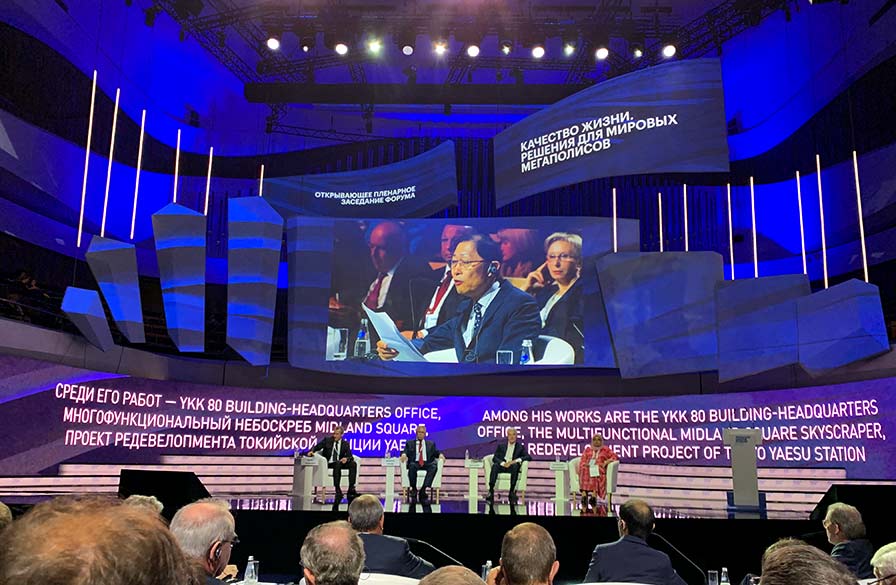Nikken Sekkei’s President and CEO Discusses TOD and Urban Planning
at Moscow Urban Forum 2019.
Moscow, Russia. July 04-07, 2019. For the 6th consecutive year, Nikken Sekkei took part in the Moscow Urban Forum as one of the event’s main speakers; among other leading urbanists, economists, architects, entrepreneurs, and public officials, as well as city activists from Russia and around the world.
From the title Quality for Life. Projects for a Better Future, the center of the discussion was the quality of life in cities nowadays. Megacities focus their efforts on the improvement of the quality of urban environment, the development of housing, transport, and social infrastructure, and the launch and expansion of a wide range of urban services, as well as the promotion of their cities as tourist destinations. Thus, the overall objective of city administrations is the enhancement of quality of life and the provision of services for the well-being of their citizens.
During the opening plenary session of the Forum, focused on Quality of Life. Solutions for Global Megacities, Nikken Sekkei’s President and CEO, Mr. Tadao Kamei, presented the company’s vision for and experience in Urban Planning and TOD, and its contribution to the essential role of hubs to reduce the pressure on city centres. In Japan, TOD hubs are constantly being improved. This continuous evolutionary process aims to create better integration and higher level of comfort for citizens. For example, in a super aging society like Japan, it has become fundamental for hubs to be barrier free and “silver society” friendly.
During the second day of the event, focused on Development Priorities. Projects Changing Moscow, Mr. Kamei was engaged in the topic of master planning and multifunctional complexes. Mr. Kamei introduced the Tokyo Station Yaesu Development as a case study related to high land price, to demonstrate that large scale development and long-term vision have a significant impact on changing the mono-polar structure of a city. In the Tokyo Station Yaesu Development, for example, attention was paid to taking advantage of underground spaces to provide better connectivity and use of spaces. The Tokyo Station area has over 100,000 square metres of well-utilized underground spaces and a network extending some 800 meters connecting the surrounding buildings to the station.
From the title Quality for Life. Projects for a Better Future, the center of the discussion was the quality of life in cities nowadays. Megacities focus their efforts on the improvement of the quality of urban environment, the development of housing, transport, and social infrastructure, and the launch and expansion of a wide range of urban services, as well as the promotion of their cities as tourist destinations. Thus, the overall objective of city administrations is the enhancement of quality of life and the provision of services for the well-being of their citizens.
During the opening plenary session of the Forum, focused on Quality of Life. Solutions for Global Megacities, Nikken Sekkei’s President and CEO, Mr. Tadao Kamei, presented the company’s vision for and experience in Urban Planning and TOD, and its contribution to the essential role of hubs to reduce the pressure on city centres. In Japan, TOD hubs are constantly being improved. This continuous evolutionary process aims to create better integration and higher level of comfort for citizens. For example, in a super aging society like Japan, it has become fundamental for hubs to be barrier free and “silver society” friendly.
During the second day of the event, focused on Development Priorities. Projects Changing Moscow, Mr. Kamei was engaged in the topic of master planning and multifunctional complexes. Mr. Kamei introduced the Tokyo Station Yaesu Development as a case study related to high land price, to demonstrate that large scale development and long-term vision have a significant impact on changing the mono-polar structure of a city. In the Tokyo Station Yaesu Development, for example, attention was paid to taking advantage of underground spaces to provide better connectivity and use of spaces. The Tokyo Station area has over 100,000 square metres of well-utilized underground spaces and a network extending some 800 meters connecting the surrounding buildings to the station.
